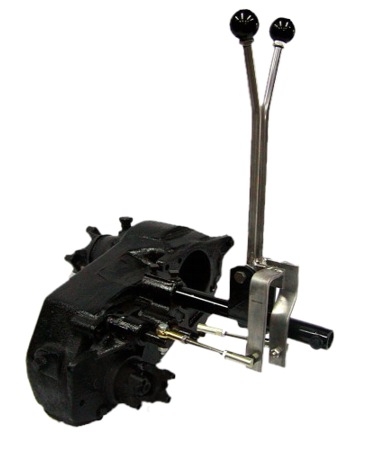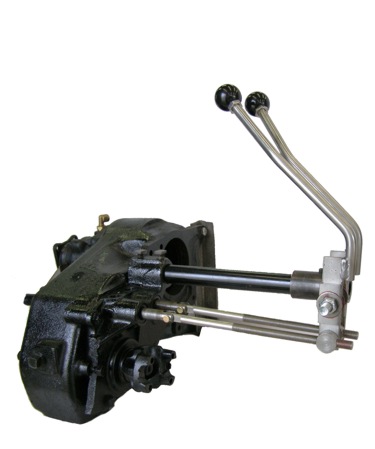Adapting the
Chevrolet & GM Standard Shift Bellhousings
to the
Jeep T98 Transmission
as found in
Utility Wagons, Trucks & Gladiator Trucks
This kit is for Jeep Wagons & Trucks that were factory equipped with the I6 engines and the Borg-Warner T98.
Product & Features

The adapter is 1-1/2 " long comprised of cast and machined high-grade aluminum alloy, featuring thick flanges, a heavy cross-section. This kit is used in conjunction with the 1" iron factory adapter plate found in these trucks. See descriptions below for bellhousing options.
Contents
Included is the adapter housing, GM bellhousing locator / throwout sleeve, seal, and hardware.
The adapter is 1-1/2 " long comprised of cast and machined high-grade aluminum alloy, featuring thick flanges, a heavy cross-section. This kit is used in conjunction with the 1" iron factory adapter plate found in these trucks. See descriptions below for bellhousing options.
Contents
Included is the adapter housing, GM bellhousing locator / throwout sleeve, seal, and hardware.
Applications & Compatibility
Applications & Compatibility
Engines
Engine bellhousings using a standard GM rear bolt pattern. GM bellhousings feature either a 4-11/16" rear face bore or a 5-1/8" rear face bore, the latter typically only from Chevy / GM trucks from 1968-1991. Our adapter will work with both. If you are uncertain of your bellhousing bore, choose the 5-1/8" press-on spacer ring that can be used or omitted to cover either situation. The ring is easily returnable for credit if not used in the installer's application.
Transmissions
This kit is for Jeep Wagons & Trucks that were factory equipped with the I6 engines and the Borg-Warner T98. Jeep T98's can vary, and some versions require special adapter components.
For M715 trucks, see our #C715 kit.
Related Products
Bellhousings and adapter rings
The BR4 ring is used to enable use of the SM465 5-1/8” bore bellhousing with 4-11/16” retainers.

If you need a bellhousing, would prefer a new enhanced casting version or would like the LS specific version they can be purchased here:
Chevrolet pattern, Gen I & II small 4 11/16” bore
Chevrolet pattern, Gen I & II large 5 1/8” bore
Chevrolet pattern, Gen III & IV small 4 11/16” bore
Chevrolet pattern, Gen III & IV large 5 1/8” bore
Pilot Bushings & Bearings
LS flywheel
This is a beautiful piece and necessary for proper operation on LS based engines. They must have the LS crank offset to work properly. These will accept both the 11” and 12” clutch listed below. The page is here with details.

Bolts necessary for installation

Clutch Kit
A quality clutch is always necessary with your installation. We recommend a diaphragm type especially if using the hydraulic conversion. Three sizes are listed below. Most common is the 11” listed in the middle but all are serviceable depending on your needs. Generally the 10-1/2” is used on the smaller 153 tooth flywheel and is exclusive to that application. The 11” and 12” are usually interchangeable with large bellhousings and standard 168 tooth flywheels. Non-standard applications will need to watch for compatibility.

The disc can be purchased separately for those applications natively using a different spline count.


Clutch Release System
Both factory mechanical and factory hydraulic clutch release systems can be made fully compatible with this conversion. A more involved discussion of this topic can be read here.
Adjustable Release Bearing
While sometimes not needed in this application, Novak's unique and adjustable throwout bearing assures the right height of bearing, which is the most important factor in any clutch system's successful operation.

We frequently reach for this adjustable bellhousing arm pivot, which adds additional adjustability and better release arm angles.

Mechanical Linkage
Installers using mechanical releases should use Novak's #RAGM release fork, which features the correct leverage ratio for a GM pressure plate in these Jeeps.

Hydraulic Clutch Actuation
Though not required on all applications, now is an excellent opportunity to upgrade from the likely worn mechanical system. These mechanical systems are usually full of play which is aggravated by years of wear and much more affected by flex in the body/frame relationship, especially when in a twist off-road. You will find that your clutch release point will vary as things twist. With a hydraulic system, that is not the case. All flex is taken up by the braided stainless line which is unaffected by changes in frame to body relationship. If your Jeep has the master cylinder, that part can be reused. More information can be found here.
Parts to do this swap are:
Transmission Tunnel Cover
Because the transmission and transfer case shifters are often in a different location than factory in these Jeeps, this new transmission tunnel cover gives the installer a clean slate. There are no screw holes nor transmission & transfer case shifter holes, allowing the installer to drill and cut them as necessary. An easy way to get a perfect fit is to use the old cover as a template, making cuts as necessary, then overlay on the new aluminum piece for perfect holes.
The finish is natural brushed aluminum, which looks pretty terrific, but it can easily be primed and painted to suit, if desired.
This tunnel cover is compatible only with 1976-1986 CJ Jeeps.

T98 Rebuild Kits
Though complete disassembly of your transmission is not required to install our new output shaft, often this is a great time to rebuild a tired or unknown unit. These rebuild kits offer the best available components, bearings, synchros, gaskets, and seals to perform a first rate rebuild along with your installation. Our instructions accompany all rebuild kits.

Sticks
Straight sticks are available if yours is work or you simply want to start with a clean slate to get the bends right.

D20 Transfer Case Shifters
The stock transfer case shifter may be used, possibly requiring minor modifications. On the Dana 20 it is often advantageous to use a new twin stick style shifter, especially if you are able to remove the interlock pins during the transfer case rebuild process. Multiple models are available depending on your original transmission mated to the D20. It is also possible to retrofit a longer length shifter by using our replacement tubing and TX20-COM4 sold below. You will likely need to re-bend the shifter levers for correct positioning but this gives a sound starting point. Going this route allows the shifter to be positioned further forward in relation to the transfer case which allows a location closer to stock as the transfer case moves back with the longer length TH350.





This is the tubing necessary to fabricate a custom length shifter, sold by the inch.
All would require the

Installation Requirements
The adapter is easily and quickly installed onto the T98 using normal mechanics tools. Instructions are included.
Placement
Engine placement in these applications is an effort in compromise to find the best position overall as a package. Generally the engine will be about 1” or even more towards the left, (driver’s side in the USA) away from the front differential in a CJ application. This gives the best balance of weight, and more importantly clearance, for the driveshaft going to the front axle. Your tight spots will be steering to exhaust on the left (hold that as tight as you can) and clearance for the front driveshaft on the right. On a driver’s side drop transfer case, usually the later Jeeps, things often get a little easier as steering and front driveshaft are pushing you the same direction. Fore and aft position will vary with the Jeep model and engine.
Have a CJ5 and Gen I with a rear distributor? You’ll be better off a little forward for more rear driveshaft length and clearance for that HEI. If you are in a longer Jeep and using an LS engine with no distributor, you’ll have more fan clearance and better balance if you hold it to the rear. Usually for ground clearance tuck things up nicely for height to avoid damage to oil pans and other life giving parts in the Jeep. On later Jeeps with a Driver’s side drop transfer case and front differential, things are a little easier as the steering and offset are both pushing the drivetrain to the passenger’s side. Again, that 1 to 1-1/2” dimension is usually where you want to be. Common sense and taking a step back to look at things overall goes a long way.
Driveshafts
Driveshaft length changes are often required. Most conversions to these transmissions will require that the rear driveshaft be modified to be shorter and front driveshaft longer.
Some installers, concerned about the expense of new or modified driveshafts, attempt to let the existing driveshafts dictate engine, transmission and transfer case location, often to the detriment of the project. Our recommendation is to prioritize the correct position of drivetrain components over saving a few dollars which is usually regretted in the long run with compromised positioning.
Driveshaft modifications and rebalancing can be affordable when performed by driveline, RV or tractor implement specialists. New driveshafts are an option, but not necessarily a requirement in regards to the actual successful conversion if your existing driveshafts are in good condition.
Jeeps that require extensive travel or specialty-built driveshafts have this option available through several fabricators across the nation. These are normally specified after placement of the new transmission and measured at vehicle ride height. As the rear driveline gets shorter, it is often advantageous to us a Double Cardan or “CV style” rear shaft with the correct geometry at the axle to minimize vibrations and possible binding.
Axles
Use of factory axles is completely acceptable with this conversion. Axle upgrades are not necessary, but they may be chosen for reasons external to this transmission upgrade.
Also See
- The Novak Guide to the Borg-Warner T98 Transmission
- The Novak Guide to Clutches, Linkages & Bellhousings for Jeep® Conversions
- The Novak Guide to The Chevrolet Small Block V8 Engine
- The Novak Guide to the GM Generation III+ V8 Engines
- The Novak Guide to GM Gen III+ Engine Crank Spacing & Interchange
- The Novak Guide to The Chevrolet I6 Engine
- The Novak Guide to The Chevrolet Big Block V8 Engine




